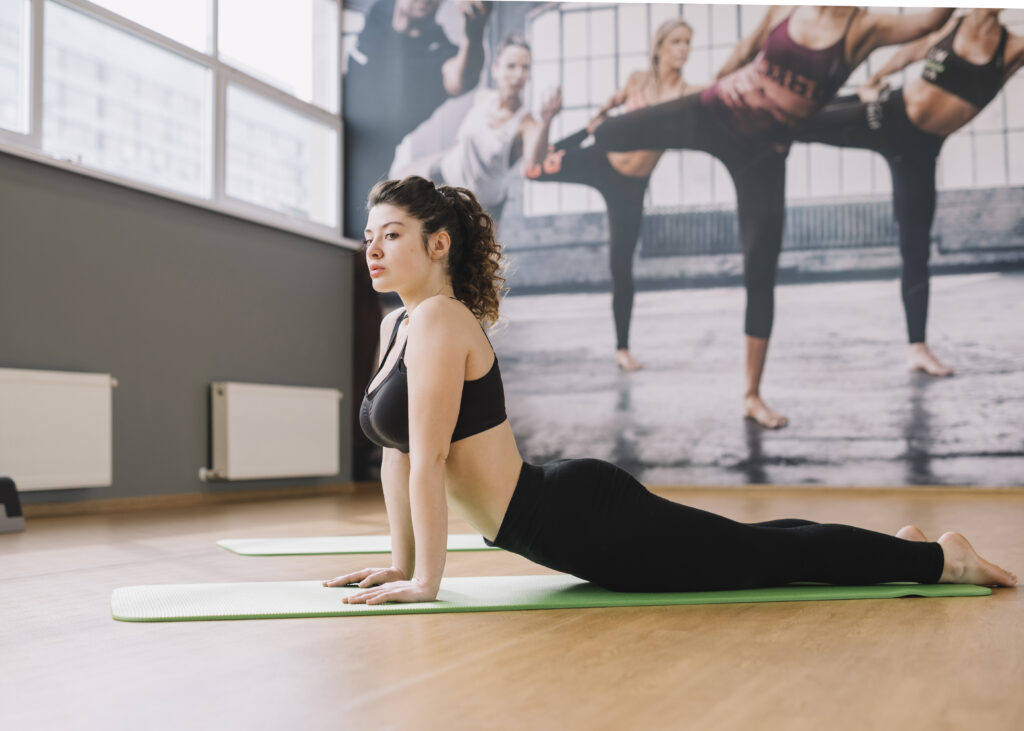Mat Pilates difference between Reformer Pilates
Table of Contents
Mat Pilates

1. Equipment:
Uses a simple mat, similar to a yoga mat, placed on the floor. No additional equipment is necessary, though small props like resistance bands or light weights may be incorporated for added challenge.
2. Resistance:
The main source of resistance in Mat Pilates is the individual’s own body weight and the gravitational force acting upon it. Movements are controlled and precise, focusing on engaging the core and stabilizing muscles.
3. Movements:
Focuses on a series of exercises that target core strength, flexibility, and stability. Common exercises include the hundred, the roll-up, leg circles, the bridge, and various stretches.
4. Intensity and Accessibility:
Generally accessible to people of all fitness levels as modifications can be made to accommodate different abilities. Suitable for home practice or group fitness classes. It offers a moderate intensity workout that can be adapted to suit individual needs.
Reformer Pilates

1. Equipment:
Utilizes a piece of equipment called a reformer, which consists of a sliding carriage attached to springs of varying resistance levels. Straps and pulleys are incorporated into the reformer for added resistance and assistance with movements.
2. Resistance:
Offers adjustable resistance through the springs attached to the reformer. The resistance can be increased or decreased to match the individual’s strength and fitness level.
3. Movements:
Provides a wider range of exercises compared to Mat Pilates due to the added resistance and versatility of the reformer machine. Exercises can target specific muscle groups more precisely, and the machine allows for more variations in movement patterns.
4. Intensity and Accessibility:
Can offer a higher intensity workout due to the adjustable resistance and ability to target specific muscle groups. Often used in more specialized studios or with a personal trainer. Reformer Pilates may require more guidance for beginners to ensure proper form and technique.
In summary, while both Mat Pilates and Reformer Pilates focus on core strength, flexibility, and stability, they differ in terms of equipment, resistance, movements, intensity, and accessibility. Mat Pilates is accessible to a wider range of individuals and can be practiced at home or in group settings, while Reformer Pilates offers a more versatile workout with adjustable resistance and targeted movements using specialized equipment.
Which one is Better in Both of Them
Determining which form of Pilates is “better” depends on individual preferences, goals, and physical condition. Both Mat Pilates and Reformer Pilates offer unique benefits, and the choice between them often comes down to personal preference and what aligns best with an individual’s needs and lifestyle. However, I can provide insights into the potential advantages of each and the science behind their effectiveness:
Mat Pilates
Advantages:
1. Accessibility: Mat Pilates requires minimal equipment and can be practiced virtually anywhere with enough space for a mat. This makes it more accessible for individuals who prefer to work out at home or who may not have access to a Pilates studio with reformer machines.
2. Functional Strength: Mat Pilates emphasizes bodyweight exercises that target core strength, stability, and flexibility. These movements often mimic everyday movements, helping to improve functional strength and reduce the risk of injury in daily activities.
3. Mind-Body Connection: Like all forms of Pilates, Mat Pilates emphasizes the mind-body connection, focusing on controlled movements, proper breathing, and mindfulness. Research suggests that practices like Pilates can improve body awareness and mindfulness, leading to better movement efficiency and reduced stress levels.
Science Behind It:
Research on Mat Pilates is somewhat limited compared to Reformer Pilates, but studies have shown that it can be effective for improving core strength, flexibility, and balance. For example, a study published in the Journal of Bodywork and Movement Therapies found that a 12-week Mat Pilates program led to significant improvements in core endurance and flexibility in healthy adults.
Mat Pilates exercises often engage multiple muscle groups simultaneously, which can help improve overall muscle tone and coordination. For example, exercises like the hundred and the roll-up target the core muscles while also engaging the stabilizing muscles of the shoulders, hips, and back.
Reformer Pilates
Advantages:
1. Adjustable Resistance: The reformer machine provides adjustable resistance through springs, allowing for a more personalized and progressive workout. This can be beneficial for individuals looking to increase strength, challenge specific muscle groups, or rehabilitate from injury.
2. Variety and Progression: Reformer Pilates offers a wide range of exercises and variations, allowing for progression as strength and proficiency improve. The machine also allows for more variety in movement patterns compared to Mat Pilates, which can help prevent boredom and plateaus in fitness.
3. Targeted Muscle Engagement: The reformer’s pulleys and straps enable precise targeting of specific muscle groups, facilitating deeper engagement and more effective strengthening and toning.
Science Behind It:
Research on Reformer Pilates is still emerging, but several studies have demonstrated its effectiveness for improving core strength, flexibility, and balance. For example, a study published in the Journal of Strength and Conditioning Research found that a 10-week Reformer Pilates program led to significant improvements in core strength and flexibility in healthy adults.
The adjustable resistance of the reformer machine allows for progressive overload, which is a key principle in strength training for muscle growth and adaptation. By gradually increasing the resistance over time, individuals can continue to challenge their muscles and see improvements in strength and endurance.
In conclusion, both Mat Pilates and Reformer Pilates offer unique benefits and can be effective forms of exercise for improving core strength, flexibility, and overall fitness. The choice between them ultimately depends on individual preferences, goals, and access to equipment and instruction. Some people may prefer the accessibility and simplicity of Mat Pilates, while others may enjoy the variety and targeted resistance of Reformer Pilates. Ultimately, the best form of Pilates is the one that you enjoy and can stick with consistently.

